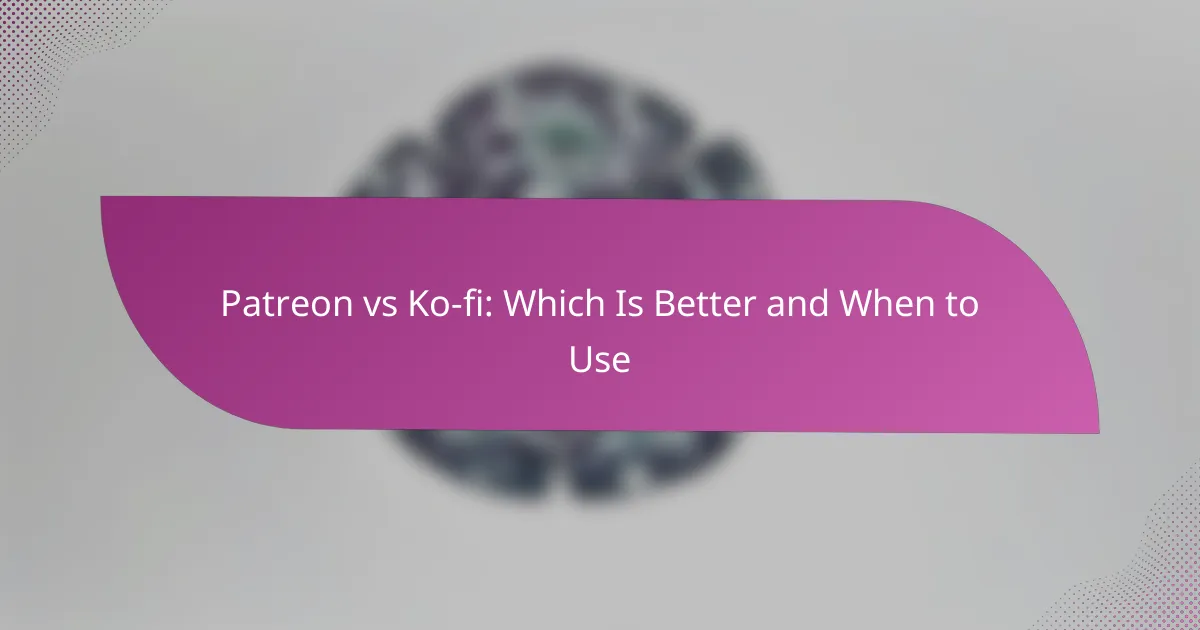When deciding between Patreon and Ko-fi, it’s essential to consider your revenue model and how you engage with your audience. Patreon is best for creators aiming for steady, subscription-based income through exclusive content, while Ko-fi is perfect for those who prefer one-time donations and a more flexible approach to support.
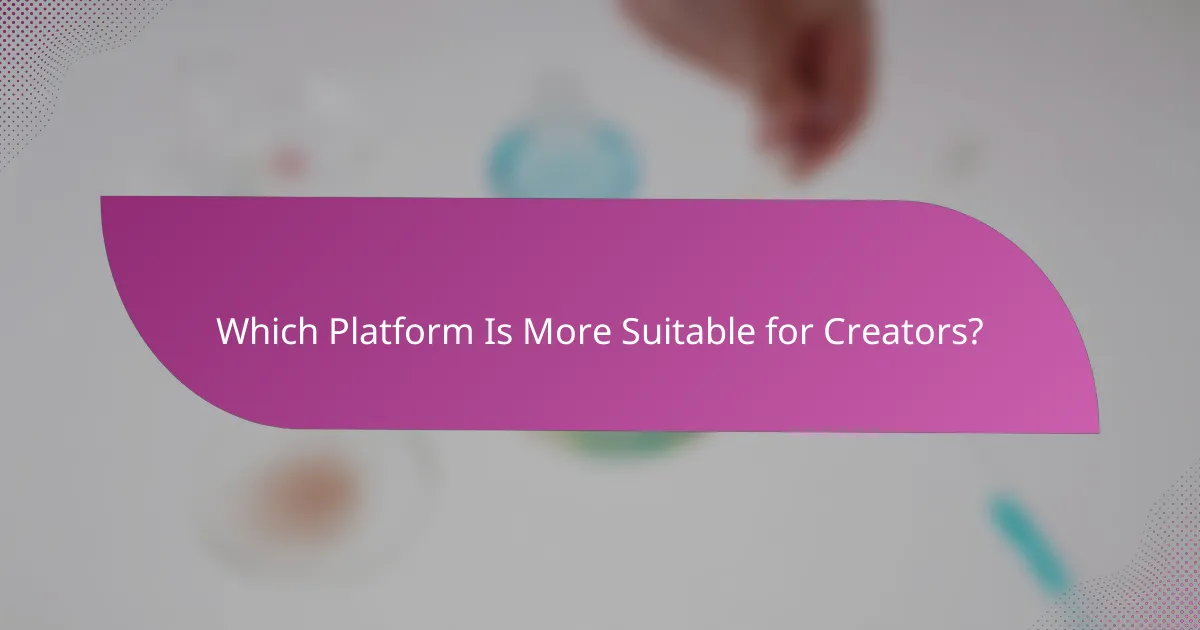
Which Platform Is More Suitable for Creators?
Choosing between Patreon and Ko-fi depends on a creator’s revenue model and audience engagement strategy. Patreon is ideal for those seeking consistent subscription-based income, while Ko-fi suits creators looking for one-time donations or tips.
Patreon for subscription-based revenue
Patreon allows creators to set up tiered subscription models where fans can support them monthly in exchange for exclusive content. This model is beneficial for creators who produce regular content, such as artists, podcasters, or writers, as it provides a predictable income stream.
Creators can offer various membership levels, often ranging from a few dollars to higher amounts, with each tier providing different perks. This encourages fans to engage more deeply, as they can choose a level that fits their budget and desired access to content.
Ko-fi for one-time donations
Ko-fi is designed for creators who prefer to receive one-time donations or tips rather than ongoing subscriptions. Users can support creators with small contributions, typically the price of a coffee, making it accessible for fans who may not want to commit to a monthly payment.
This platform is particularly appealing for creators who produce sporadic content or want to supplement their income without the pressure of maintaining a subscription service. It allows for flexibility and spontaneity in funding, which can be advantageous for many creators.
Comparison of audience engagement
Patreon often fosters a deeper relationship between creators and their supporters due to the subscription model, which encourages regular interaction through exclusive content and community features. This can lead to a more loyal fanbase that is invested in the creator’s work.
In contrast, Ko-fi tends to attract casual supporters who may engage less frequently. While it provides a straightforward way for fans to show appreciation, the lack of ongoing interaction can result in a more transactional relationship.
Platform fees and pricing structures
Patreon charges a percentage of the monthly income generated through subscriptions, typically ranging from 5% to 12% depending on the plan chosen. Additionally, payment processing fees apply, which can vary based on the payment method used.
Ko-fi operates on a different model, taking a small percentage from donations if creators opt for the Ko-fi Gold membership, which offers additional features. Without this membership, Ko-fi does not charge fees, allowing creators to keep most of their earnings from one-time donations.
Content control and ownership
Both Patreon and Ko-fi allow creators to maintain ownership of their content. However, Patreon provides more structured tools for managing content distribution, including tiered access and exclusive posts, which can enhance a creator’s ability to control how their work is shared.
On Ko-fi, creators have the freedom to share their content more openly, as the platform is less restrictive. This can be beneficial for those who want to reach a broader audience without the constraints of a subscription model.
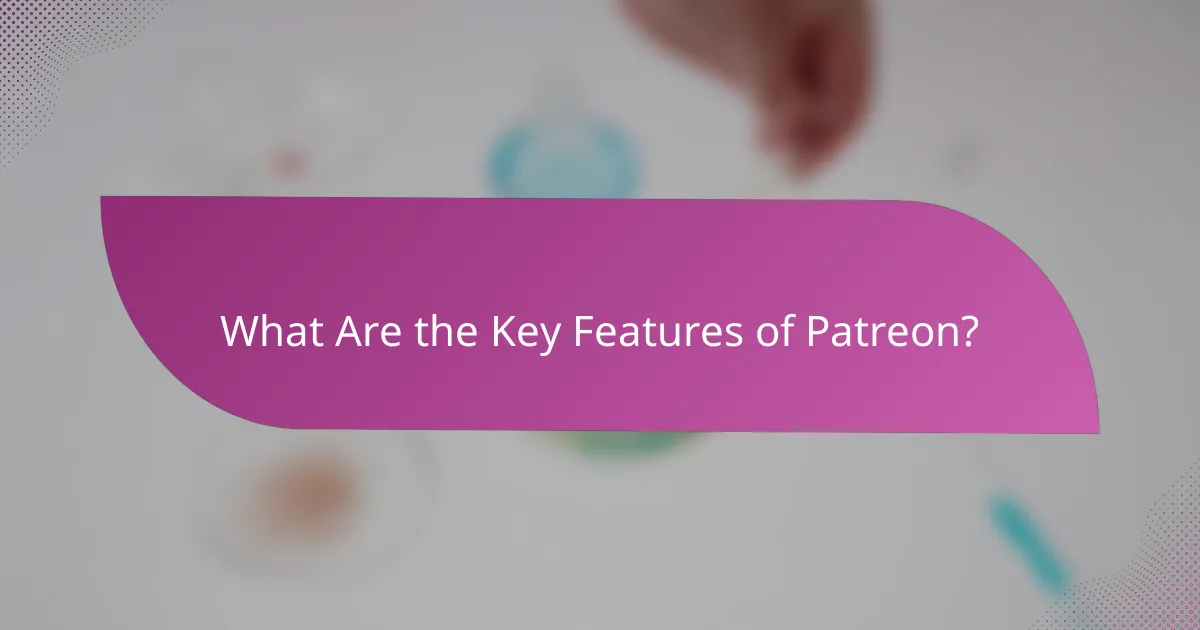
What Are the Key Features of Patreon?
Patreon is a membership platform designed to help creators earn a sustainable income by offering exclusive content and benefits to their subscribers. Key features include customizable membership tiers, various content options, and tools for community engagement.
Membership tiers and benefits
Patreon allows creators to set up multiple membership tiers, each with distinct benefits. This flexibility enables creators to cater to different audience segments, offering perks such as early access to content, exclusive merchandise, or personalized experiences.
For example, a creator might offer a basic tier at $5 per month for exclusive updates, while a premium tier at $20 could include one-on-one consultations. This tiered approach can help maximize revenue by appealing to a wider range of supporters.
Exclusive content options
Creators on Patreon can provide a variety of exclusive content types, including videos, podcasts, artwork, and written posts. This exclusivity encourages fans to subscribe, as they gain access to material not available to the general public.
Additionally, creators can use Patreon’s tools to schedule content releases, ensuring a steady flow of new material for their supporters. This can enhance subscriber retention and engagement over time.
Community engagement tools
Patreon offers several community engagement tools to foster interaction between creators and their supporters. Features like polls, comments, and direct messaging allow creators to connect with their audience, gather feedback, and build a loyal community.
Utilizing these tools effectively can lead to stronger relationships with supporters, as creators can respond to their needs and preferences. Regular engagement can also encourage subscribers to remain active and continue their support over the long term.
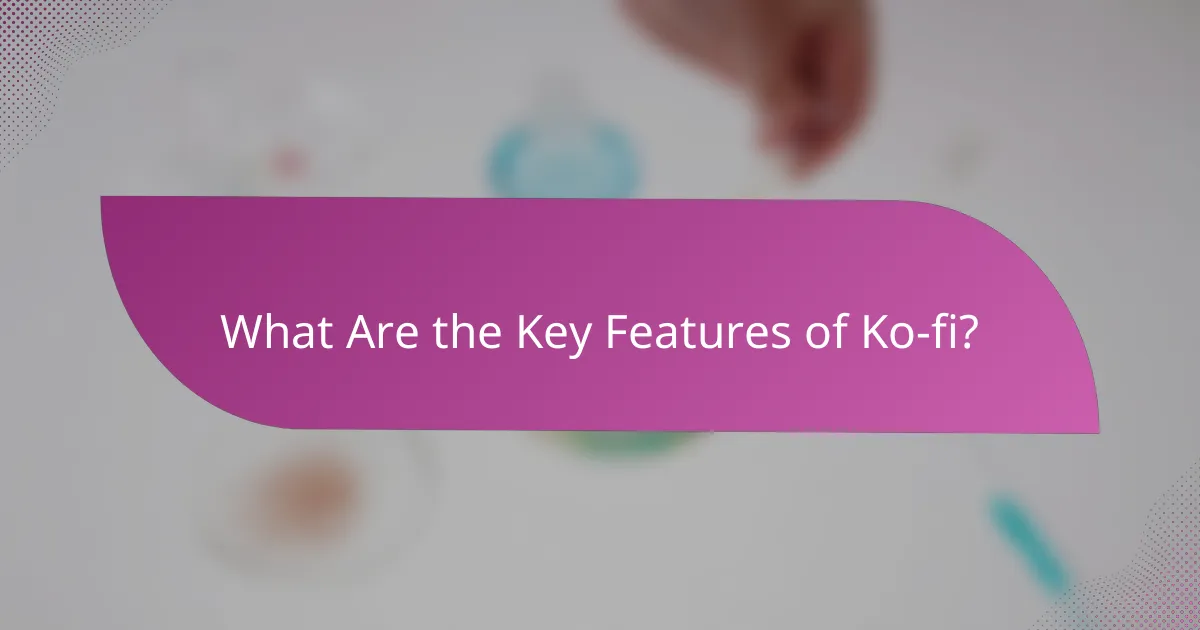
What Are the Key Features of Ko-fi?
Ko-fi offers a straightforward platform for creators to receive donations and support from their audience. It emphasizes simplicity and flexibility, making it easy for users to engage with creators through donations, shop purchases, and goal-setting features.
Simple donation model
Ko-fi’s donation model allows creators to receive one-time or recurring contributions from supporters without complex subscription tiers. Users can donate any amount, typically starting from a few dollars, which makes it accessible for fans of all financial backgrounds.
This model is particularly appealing for creators who prefer not to commit to monthly subscriptions, allowing them to focus on content creation rather than managing memberships. Creators can also express gratitude through personalized messages or shout-outs, enhancing community engagement.
Shop integration for creators
Ko-fi provides a built-in shop feature that enables creators to sell digital products, merchandise, or commissions directly to their supporters. This integration allows creators to monetize their work without needing a separate e-commerce platform.
Creators can set up their shops quickly, offering items like art prints, e-books, or exclusive content. The platform takes a small fee from sales, making it a cost-effective solution for those looking to diversify their income streams.
Goal-setting features
Ko-fi includes goal-setting tools that allow creators to define specific financial targets, such as funding a project or covering monthly expenses. Supporters can see these goals and contribute towards them, fostering a sense of community and shared purpose.
Creators can set goals at various levels, from small amounts for minor projects to larger sums for significant initiatives. This transparency encourages supporters to contribute, knowing their donations are helping achieve tangible outcomes.
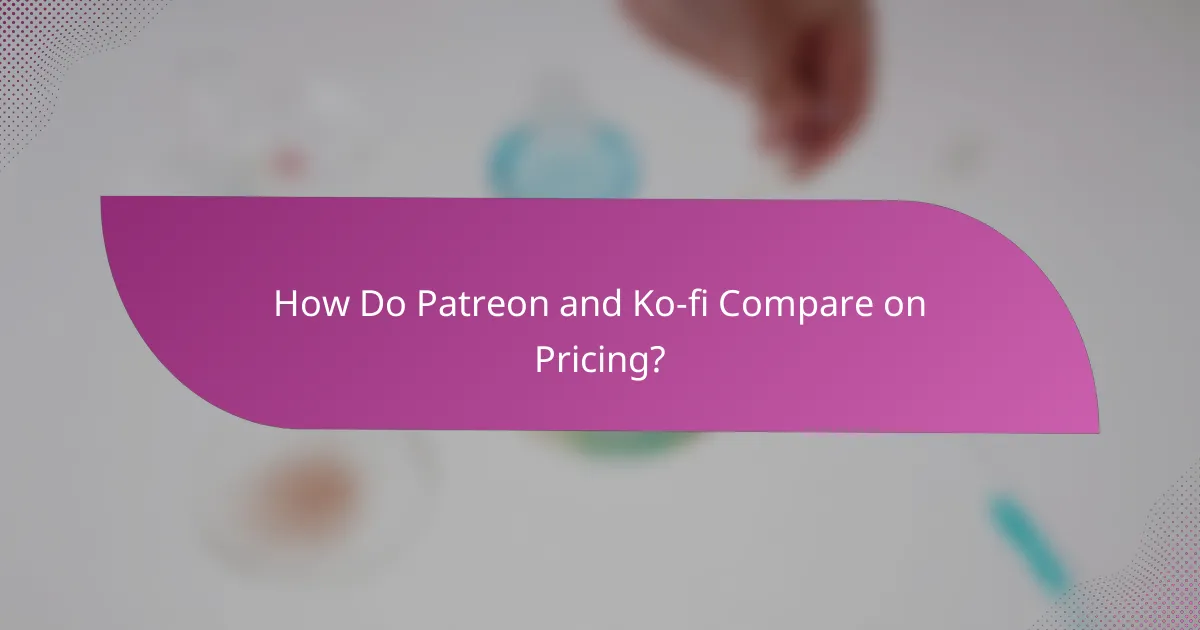
How Do Patreon and Ko-fi Compare on Pricing?
Patreon and Ko-fi have different pricing structures that can significantly affect creator earnings. While Patreon typically charges a percentage of the earnings, Ko-fi allows creators to receive donations without fees on the basic tier, making it essential to understand how each platform’s fees work.
Patreon fees and creator earnings
Patreon operates on a tiered fee structure, taking a percentage of the monthly earnings, which can range from around 5% to 12% depending on the plan chosen. Creators should also consider payment processing fees, which can add another 3% to 5% to costs. This means that for every dollar earned, creators may only keep around 80-90 cents after fees.
Additionally, Patreon allows creators to set up multiple membership tiers, which can encourage higher contributions from fans. However, creators must consistently provide value to retain subscribers, as churn rates can be high if content does not meet expectations.
Ko-fi fees and donation structures
Ko-fi operates on a different model, primarily allowing creators to receive one-time donations or tips from supporters. The basic version is free and does not charge any fees on donations, but creators can opt for Ko-fi Gold, which has a monthly fee and offers additional features like membership options and a shop. Ko-fi Gold costs around $6 per month, but it allows creators to keep 100% of donations.
Creators should consider their audience’s preferences when choosing between one-time donations and a subscription model. For those with a loyal fanbase, Ko-fi can be a straightforward way to monetize without the complexities of a subscription service, while Patreon may be better suited for those who can provide ongoing content and engagement.
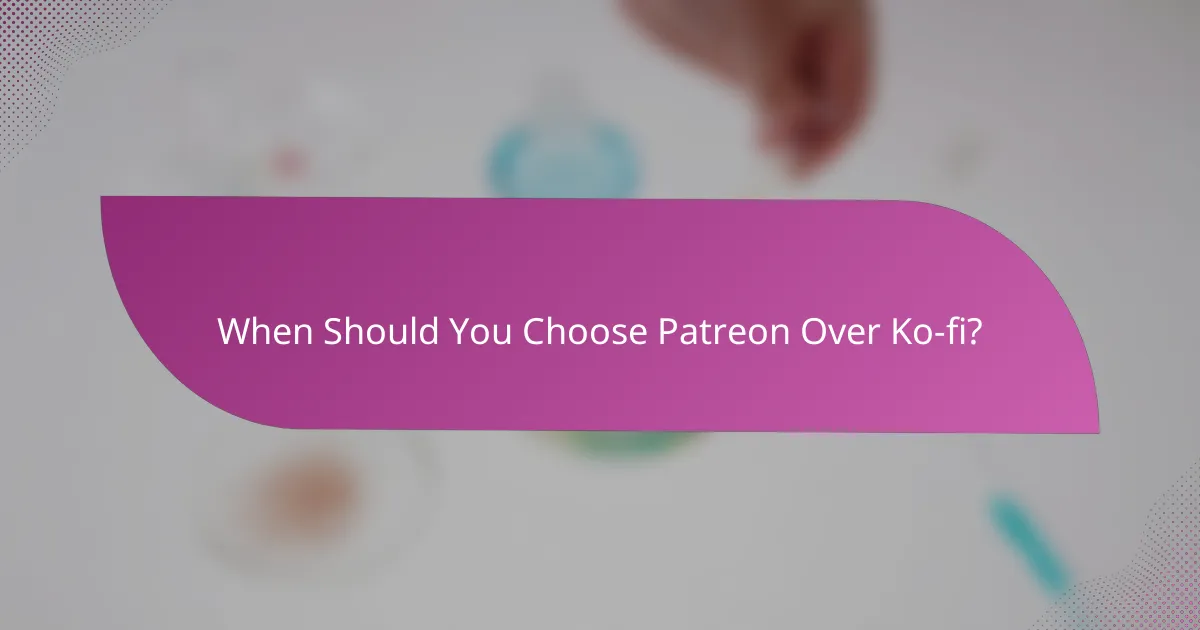
When Should You Choose Patreon Over Ko-fi?
You should choose Patreon over Ko-fi when your focus is on long-term community building and you require a steady stream of recurring revenue. Patreon is designed for creators who want to establish deeper relationships with their supporters through subscription models, while Ko-fi is more suited for one-time donations or tips.
Long-term community building
Patreon excels in fostering a dedicated community around your work. By offering tiered memberships, you can provide exclusive content, rewards, and engagement opportunities that encourage ongoing interaction. This model helps you cultivate loyal supporters who feel invested in your creative journey.
For example, you might offer different subscription levels that grant access to behind-the-scenes content, early releases, or personalized interactions. This creates a sense of belonging among your patrons, which can lead to increased retention and support over time.
Recurring revenue needs
If you need consistent income to support your creative projects, Patreon is the better choice. The subscription model allows you to predict your monthly earnings, which can help you budget and plan your work more effectively. In contrast, Ko-fi primarily facilitates one-time contributions, making it less reliable for steady cash flow.
Consider setting a goal for your Patreon subscriptions to cover essential expenses, such as software, equipment, or living costs. This way, you can focus on creating without the constant worry of fluctuating income. Aim for a target that reflects your needs, whether it’s a few hundred dollars or more, depending on your circumstances.
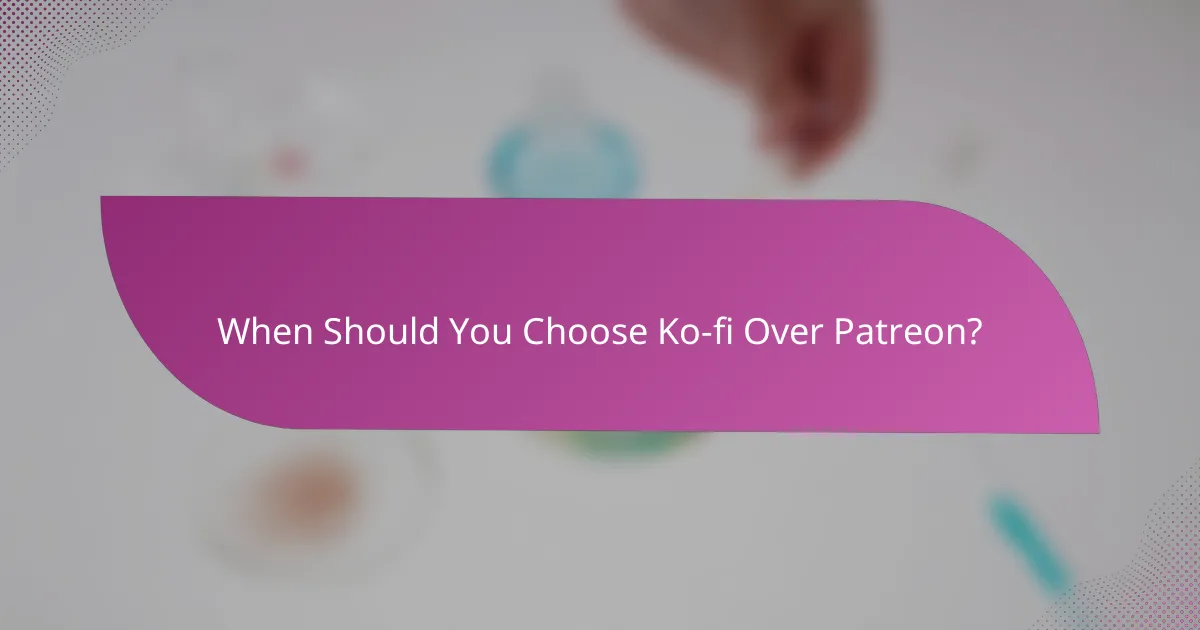
When Should You Choose Ko-fi Over Patreon?
Ko-fi is ideal for creators seeking flexibility and simplicity, particularly for one-time projects or casual support. It allows users to receive donations without the ongoing commitment that platforms like Patreon require.
One-time project funding
Ko-fi excels in facilitating one-time project funding, making it suitable for creators who need immediate financial support for specific endeavors. For instance, if you’re launching a new art piece or writing a short story, you can set a funding goal and invite your audience to contribute directly.
This model is particularly appealing for creators who want to avoid long-term commitments. You can easily communicate your project needs and allow supporters to contribute at their discretion, whether it’s a few dollars or more substantial amounts.
Low commitment for supporters
With Ko-fi, supporters can contribute without the pressure of a subscription model, making it easier for casual fans to engage. This low commitment means that even those who may not want to commit monthly can still support your work when they feel inspired.
This approach can lead to a broader audience base, as potential supporters may be more willing to donate occasionally rather than commit to ongoing payments. It’s a great way to build a community without the constraints of regular contributions.
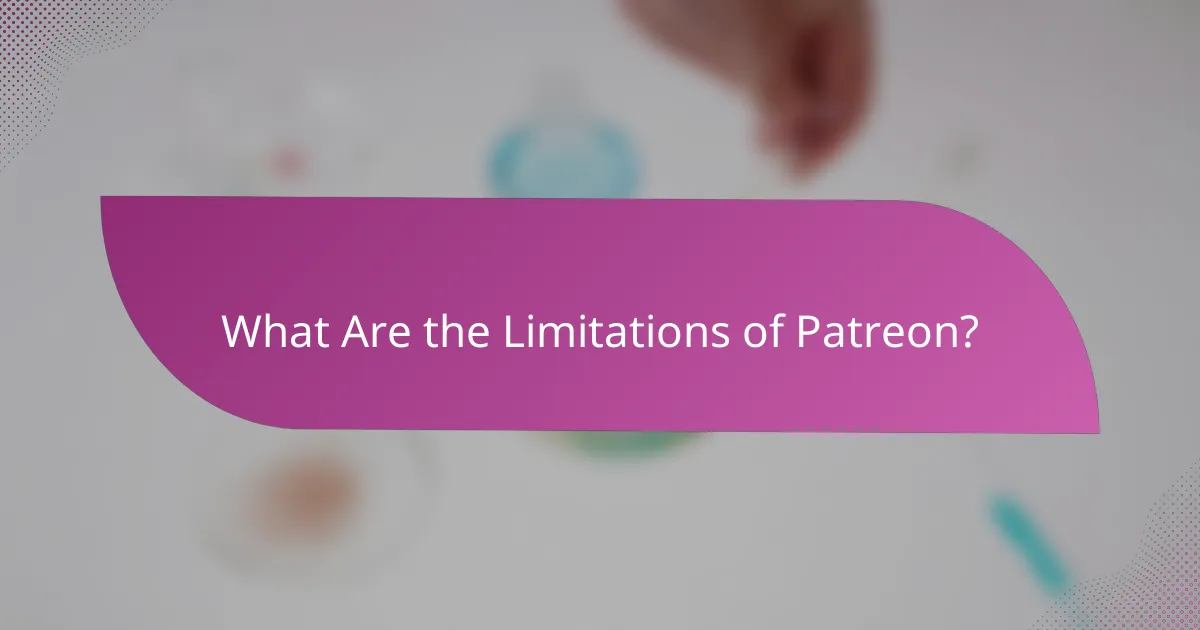
What Are the Limitations of Patreon?
Patreon has several limitations that creators should consider before using the platform. These include high fees, restrictions on content types, and challenges in managing subscriber relationships.
High Fees
Patreon charges a percentage of the earnings, typically ranging from 5% to 12%, depending on the plan chosen. This can significantly reduce the amount creators take home, especially for those with lower subscription rates. Additionally, payment processing fees can further cut into earnings, often around 3% to 5%.
Content Restrictions
Creators must adhere to Patreon’s content guidelines, which can limit the types of material shared. For instance, explicit content is heavily regulated, and violations can lead to account suspension. This can be a drawback for artists or creators whose work may not fit neatly within these boundaries.
Subscriber Management Challenges
Managing a subscriber base on Patreon can be complex, particularly as it grows. Creators may struggle with communication, fulfilling rewards, and maintaining engagement. If not handled well, this can lead to subscriber churn and dissatisfaction, impacting overall revenue.
